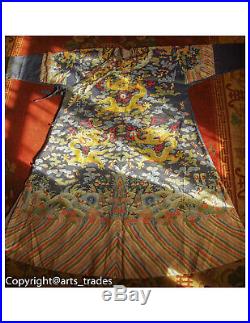


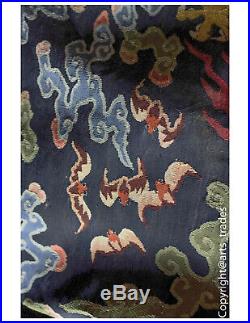
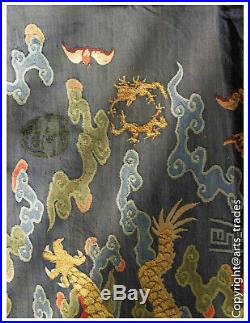
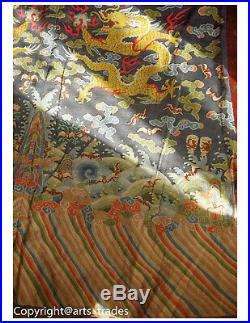



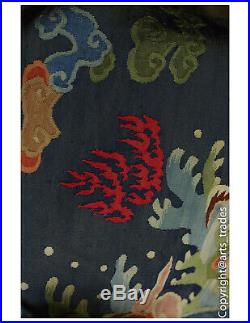
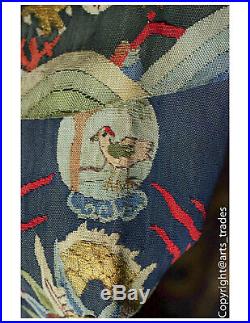
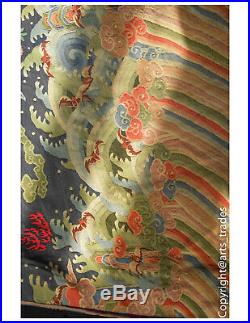

Qing Chinese Imperial Court Kesi Dragon Robe. Dimension : 51 inch x 35 inch. Condition: shows sign of age, discoloration, minor tears. Qing Dynasty, blue ground silk with kesi silk and metal thread decorations to include 5 claw dragons, flaming pearl, smoke, phoenix, cranes, bats and floral accents over crashing surface, Lishui striped bottom and each from top of shoulder to dragon decorated cuff. The Twelve Patterns of the Dragon Robes. The Emperors gowns were loaded with artful ornaments and hidden symbolism for good luck, and a dragons image dominated each imperial costume. As an important element of Confucianism, it symbolized the emperors power. A Dragon Robe contained nine dragons, one of them on each shoulder, another on the back, and one covering the breast of the top and bottom garments each; the last four dragons decorated the bottom of the imperial robes. The dragon robe was not simply meant to be an ornament for the Emperor, it was also supposed to bring good luck to the people. Apart from the dragons, eleven other symbols for good luck were featured: (rì) sun, (yuè) moon and (xngchén) stars, as the symbol for three brilliant sources of light; (qúnshn) the mountain, symbolizing protection of the emperors regency from all four directions; (huàchóng) the insect, standing for the emperors wisdom; (zngyí) the cup of wine, standing for honesty, loyalty and piety; (zo) aquatic grasses, standing for purity; (hu) fire, standing for his honesty; (fnm) rice symbolized wealth; (f) a special embroidery rendered in black and white was a symbol for the emperors decisiveness and boldness and (fú) another embroidery rendered in black and green was another symbol for honesty. Another symbol on the emperors robes was a red bat which is a homophone of the character meaning a veritable deluge of good luck. Undergarments featured the oceans and mountain ranges of the world, because in Chinese tradition the emperor was regarded as the son of heaven who rules the whole world. If you have any questions. Please Note that size and color representation are close as possible, but may not be exact. Also note that your monitor setting may vary from computer to computer and may distort actual colors. Unless you believe we had misrepresented or items do not match as described. We will resolve it for you within 48 hours. We are father and Son, specializing in Chinese and Tibetan Antiques for many Decades. My Father has been in business for almost 40 years and has a full spectrum of knowledge in area. Please feel free to. If you have any question about the items. Will be answered in 12 hours. We honor all customers and care for there satisfaction. Your satisfaction is our priority and a pleasant experience is our sole duty. Thank you for visiting us! The item “Qing Chinese Imperial Court Kesi Dragon Robe” is in sale since Sunday, November 17, 2019. This item is in the category “Antiques\Asian Antiques\Mongolia”. The seller is “arts_trades” and is located in Boudha Nath – Kathmandu. This item can be shipped to United States.
- Region of Origin: China
- Age: Pre-1800
- Primary Material: Silk & Fabric
- Original/Reproduction: Antique Original
- Type: Robe & Textile
- Color: Multi-Color
